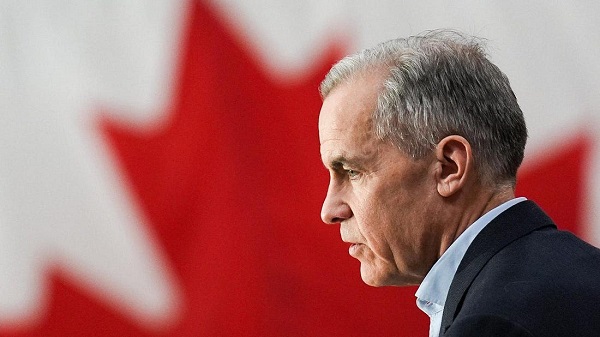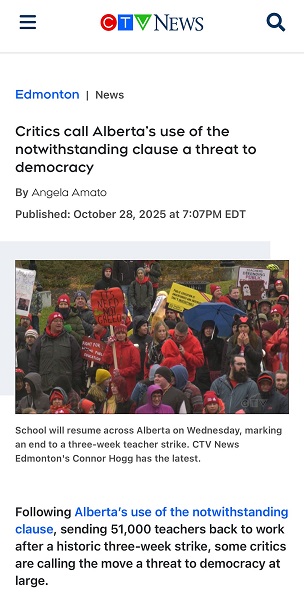Alberta
Energy East May be the Nation Building Mega-Project Canada Needs Right Now

From EnergyNow.Ca
By Jim Warren
Is it Time to Put Politics Aside for Team Canada? – Jim Warren
People on the prairies who understand the value of a flourishing oil and gas sector are hopeful the election of a Conservative government will sweep away the barriers that blocked the Northern Gateway and Energy East pipelines. Some optimistic industry analysts suggest a project similar to Northern Gateway may be doable but concede that reviving Energy East would probably be a bridge too far.
It is getting difficult to recount exactly how many times Quebec’s demands for special treatment have disrupted national unity. Quebec’s rejection of Energy East was the most recent assault on national cohesion to anger large numbers of people on the prairies. It amounted to sticking a finger in the eye of the oil-producing provinces. And while the Poilievre Conservatives are set to win the next election, their victory won’t signal a big change in attitudes about the environment in Quebec.
Politicians from Quebec argue over which of their parties can claim it hates pipelines the most. Bloc Québécois leader, Yves-François Blanchet brags about the prominent role his party played in killing Energy East. His boasting actually drew the ire of Quebec Liberals and environmental groups in 2019. They claimed the Bloc was taking credit for their work. The 338Canada website, has the anti-oil Bloc Québécois winning 45 of the 78 federal seats in Quebec in the upcoming federal election.
Provincially, the Coalition Avenir Québec (CAQ) government is marginally more reasonable to deal with. It claims to stand for Quebec’s national autonomy as opposed to outright separation. Quebec premier, François Legault, says the west would do well to behave more like politicians from his province when dealing with Ottawa. He makes a good point.
Revisiting just how eminently reasonable the original Energy East proposal actually was suggests many Quebec politicians are immune to common sense. If the Energy East proposal wasn’t acceptable to the overly zealous activists who influence environmental policy in the province, why would we expect a different response in the near future?
There are, however, coercive options that might work. Premiers from Alberta and Saskatchewan have proposed withholding a portion of Quebec’s annual equalization payment in response to its lack of cooperation on building a pipeline to tidewater on the Atlantic coast. Unfortunately that option would require a constitutional amendment, and those have proven to be extremely difficult to engineer.
Alternatively, prairie governments might encourage Enbridge to shut down its Line 9 pipeline which has the capacity to transport up to 300 barrels per day (bpd) of western oil to Montreal. That sort of move would require getting industry players on side–including Enbridge and Suncor, who owns a 137,000 bpd capacity refinery in Montreal. It is encouraging to recall that Peter Lougheed faced little in the way of industry opposition in the 1970s when he cut oil shipments to Central Canada by 10%.
Quebec’s past behavior pretty much guarantees the province would threaten separation if confronted with the loss of its equalization welfare ($14 billion for fiscal 2023-24). They might be less concerned about getting a pipeline from the west turned off—they seem to prefer tanker ships over pipelines.
Many westerners are weary of Quebec’s separation blackmail. Some of those who have run out of patience say, “next time they threaten to go, just tell them not to let the door hit them on the ass on their way out.”
The cancellation of the Energy East pipeline was viewed on the prairies as rejection of a project that would generate greater national harmony. It was seen as a nation building exercise of benefit to Quebecers, people from the Maritimes, Ontario and Western Canada. Westerners mistakenly assumed even environmentally sanctimonious Quebecers would recognize the benefits of obtaining more of their oil from pipelines rather than via marginally risky railways and ocean going tankers.
Following the 2013 Lac-Mégantic rail disaster, people from western Canada’s oil patch naively assumed approval of Energy East was a no brainer. The disaster killed 47 people and destroyed downtown Lac- Mégantic. It was caused by the derailment and explosion of a train hauling oil tanker cars. It seemed reasonable to imagine Quebecers would happily purchase safer, less expensive Canadian oil transported by pipeline.
Energy East would have been the longest pipeline in North America. It was to run from Alberta to Saint John, New Brunswick. The plan was to convert 2,900 miles of existing natural gas pipeline into an oil pipeline, build 1,900 miles of new pipeline and make a $300 million upgrade to an Irving oil terminal in New Brunswick. It was a visionary project reminiscent of the building of the transcontinental railway and the original TransCanada pipeline.
The pipeline would be capable of transporting 1.1 million bpd. No more than 400,000 bpd would be required to replace the foreign oil being imported by tanker and rail. The remaining 600,000 barrels could be exported to new international customers for Canadian oil. The value of those new export revenues would conceivably approach $15 billion annually.
It is worth remembering the influential role Quebec Liberals played in opposing Energy East. Montreal’s Mayor Denis Coderre, was a former Liberal cabinet minister who led the Montreal Municipal Community (MMC) a coalition of 82 Montreal area municipal governments. As much as anything, the MMC’s strident opposition to Energy Easy in January of 2016 foretold TransCanada’s October 2017 cancellation of the pipeline.
Inspiration for cancelling the pipeline was provided by Quebec’s robust environmental lobby—led by activists like Steven Guilbeault. Polls conducted at the time showed the Quebec politicians who opposed Energy East had the support of 60% or more of the public. The pipeline was similarly denounced by premier Philippe Couillard and Quebec’s Liberal government at the time. While the southwest corner of B.C. has typically been thought of as the home of Canada’s Greens, in Quebec the Liberals are the party preferred by environmental activists.
Liberals in Ottawa remained officially neutral during the Energy East controversy but were unofficially cheering for the pipeline’s cancellation from the sidelines.
One of the biggest challenges to confront an effort to revive the project would be finding willing investors. TransCanada walked away financially bruised and who wants to be similarly burnt? And, the Trans Mountain example casts a dark shadow on the idea of a government-owned line.
Trying to convince Quebecers, especially young adults, about the value of new oil pipelines seems like a fool’s errand. Given that only 50% of 16-20 year-olds in Quebec have a driver’s license, it could prove difficult convincing them about the importance of petroleum to Canada’s transportation system and economic health.
No less discouraging is the fact that Quebec’s environmental movement remains dedicated to killing the petroleum and natural gas industries on behalf of combatting climate change.
Yet, oddly enough there have been surprising signals coming out of Quebec in recent years suggesting regular Quebecers don’t share the same level of anti-oil and anti-pipeline enthusiasm as their province’s politicians and environmentalists. Perhaps this is something worth looking into before giving up entirely on the idea of a pipeline to Atlantic tidewater.
Alberta
Alberta government’s plan will improve access to MRIs and CT scans

From the Fraser Institute
By Nadeem Esmail and Tegan Hill
The Smith government may soon allow Albertans to privately purchase diagnostic screening and testing services, prompting familiar cries from defenders of the status quo. But in reality, this change, which the government plans to propose in the legislature in the coming months, would simply give Albertans an option already available to patients in every other developed country with universal health care.
It’s important for Albertans and indeed all Canadians to understand the unique nature of our health-care system. In every one of the 30 other developed countries with universal health care, patients are free to seek care on their own terms with their own resources when the universal system is unwilling or unable to satisfy their needs. Whether to access care with shorter wait times and a more rapid return to full health, to access more personalized services or meet a personal health need, or to access new advances in medical technology. But not in Canada.
That prohibition has not served Albertans well. Despite being one of the highest-spending provinces in one of the most expensive universal health-care systems in the developed world, Albertans endure some of the longest wait times for health care and some of the worst availability of advanced diagnostic and medical technologies including MRI machines and CT scanners.
Introducing new medical technologies is a costly endeavour, which requires money and the actual equipment, but also the proficiency, knowledge and expertise to use it properly. By allowing Albertans to privately purchase diagnostic screening and testing services, the Smith government would encourage private providers to make these technologies available and develop the requisite knowledge.
Obviously, these new providers would improve access to these services for all Alberta patients—first for those willing to pay for them, and then for patients in the public system. In other words, adding providers to the health-care system expands the supply of these services, which will reduce wait times for everyone, not just those using private clinics. And relief can’t come soon enough. In Alberta, in 2024 the median wait time for a CT scan was 12 weeks and 24 weeks for an MRI.
Greater access and shorter wait times will also benefit Albertans concerned about their future health or preventative care. When these Albertans can quickly access a private provider, their appointments may lead to the early discovery of medical problems. Early detection can improve health outcomes and reduce the amount of public health-care resources these Albertans may ultimately use in the future. And that means more resources available for all other patients, to the benefit of all Albertans including those unable to access the private option.
Opponents of this approach argue that it’s a move towards two-tier health care, which will drain resources from the public system, or that this is “American-style” health care. But these arguments ignore that private alternatives benefit all patients in universal health-care systems in the rest of the developed world. For example, Switzerland, Germany, the Netherlands and Australia all have higher-performing universal systems that provide more timely care because of—not despite—the private options available to patients.
In reality, the Smith government’s plan to allow Albertans to privately purchase diagnostic screening and testing services is a small step in the right direction to reduce wait times and improve health-care access in the province. In fact, the proposal doesn’t go far enough—the government should allow Albertans to purchase physician appointments and surgeries privately, too. Hopefully the Smith government continues to reform the province’s health-care system, despite ill-informed objections, with all patients in mind.
Alberta
Canada’s heavy oil finds new fans as global demand rises

From the Canadian Energy Centre
By Will Gibson
“The refining industry wants heavy oil. We are actually in a shortage of heavy oil globally right now, and you can see that in the prices”
Once priced at a steep discount to its lighter, sweeter counterparts, Canadian oil has earned growing admiration—and market share—among new customers in Asia.
Canada’s oil exports are primarily “heavy” oil from the Alberta oil sands, compared to oil from more conventional “light” plays like the Permian Basin in the U.S.
One way to think of it is that heavy oil is thick and does not flow easily, while light oil is thin and flows freely, like fudge compared to apple juice.
“The refining industry wants heavy oil. We are actually in a shortage of heavy oil globally right now, and you can see that in the prices,” said Susan Bell, senior vice-president of downstream research with Rystad Energy.
A narrowing price gap
Alberta’s heavy oil producers generally receive a lower price than light oil producers, partly a result of different crude quality but mainly because of the cost of transportation, according to S&P Global.
The “differential” between Western Canadian Select (WCS) and West Texas Intermediate (WTI) blew out to nearly US$50 per barrel in 2018 because of pipeline bottlenecks, forcing Alberta to step in and cut production.
So far this year, the differential has narrowed to as little as US$10 per barrel, averaging around US$12, according to GLJ Petroleum Consultants.
“The differential between WCS and WTI is the narrowest I’ve seen in three decades working in the industry,” Bell said.
Trans Mountain Expansion opens the door to Asia

Oil tanker docked at the Westridge Marine Terminal in Burnaby, B.C. Photo courtesy Trans Mountain Corporation
The price boost is thanks to the Trans Mountain expansion, which opened a new gateway to Asia in May 2024 by nearly tripling the pipeline’s capacity.
This helps fill the supply void left by other major regions that export heavy oil – Venezuela and Mexico – where production is declining or unsteady.
Canadian oil exports outside the United States reached a record 525,000 barrels per day in July 2025, the latest month of data available from the Canada Energy Regulator.
China leads Asian buyers since the expansion went into service, along with Japan, Brunei and Singapore, Bloomberg reports. 
Asian refineries see opportunity in heavy oil
“What we are seeing now is a lot of refineries in the Asian market have been exposed long enough to WCS and now are comfortable with taking on regular shipments,” Bell said.
Kevin Birn, chief analyst for Canadian oil markets at S&P Global, said rising demand for heavier crude in Asia comes from refineries expanding capacity to process it and capture more value from lower-cost feedstocks.
“They’ve invested in capital improvements on the front end to convert heavier oils into more valuable refined products,” said Birn, who also heads S&P’s Center of Emissions Excellence.
Refiners in the U.S. Gulf Coast and Midwest made similar investments over the past 40 years to capitalize on supply from Latin America and the oil sands, he said.
While oil sands output has grown, supplies from Latin America have declined.
Mexico’s state oil company, Pemex, reports it produced roughly 1.6 million barrels per day in the second quarter of 2025, a steep drop from 2.3 million in 2015 and 2.6 million in 2010.
Meanwhile, Venezuela’s oil production, which was nearly 2.9 million barrels per day in 2010, was just 965,000 barrels per day this September, according to OPEC.
The case for more Canadian pipelines

Worker at an oil sands SAGD processing facility in northern Alberta. Photo courtesy Strathcona Resources
“The growth in heavy demand, and decline of other sources of heavy supply has contributed to a tighter market for heavy oil and narrower spreads,” Birn said.
Even the International Energy Agency, known for its bearish projections of future oil demand, sees rising global use of extra-heavy oil through 2050.
The chief impediments to Canada building new pipelines to meet the demand are political rather than market-based, said both Bell and Birn.
“There is absolutely a business case for a second pipeline to tidewater,” Bell said.
“The challenge is other hurdles limiting the growth in the industry, including legislation such as the tanker ban or the oil and gas emissions cap.”
A strategic choice for Canada
Because Alberta’s oil sands will continue a steady, reliable and low-cost supply of heavy oil into the future, Birn said policymakers and Canadians have options.
“Canada needs to ask itself whether to continue to expand pipeline capacity south to the United States or to access global markets itself, which would bring more competition for its products.”
-

 Business2 days ago
Business2 days agoTrump’s Tariffs Have Not Caused Economy To Collapse
-

 Alberta1 day ago
Alberta1 day agoAlberta government’s plan will improve access to MRIs and CT scans
-

 Daily Caller2 days ago
Daily Caller2 days agoTrump Reportedly Planning Ground Troops, Drone Strikes On Cartels In Mexico
-

 Brownstone Institute2 days ago
Brownstone Institute2 days agoBizarre Decisions about Nicotine Pouches Lead to the Wrong Products on Shelves
-

 International2 days ago
International2 days agoHours after Trump’s warning, Nigerian Christians massacred by Islamist gunmen
-

 Economy1 day ago
Economy1 day agoWelcome to the Energy Humanist Club! Bill Gates breaks the moral monopoly against fossil fuels
-

 Business1 day ago
Business1 day agoCarney government’s first budget should signal end to crippling ‘climate’ policies
-

 Business1 day ago
Business1 day agoNo Jobs Clause: Liberals Under Fire Over Stellantis Deal in Fiery Committee Showdown












